From the helicopter we looked down on the lazy Iguaçu River as it meandered its way through the dense jungle. In the distance, spray was shooting high above the trees letting us know where we were going. Then all of a sudden, the river became a torrent, crashing over the cliffs in hundreds of spots. Seeing so many waterfalls coming from its source was one of the most spectacular things we’ve ever seen. Visiting Iguaçu Falls is a must on anyone’s trip to Brazil.
Iguaçu National Park
Iguaçu River shapes a part of the border between Brazil and Argentina. Near its end, it falls off a tall, horseshoe shaped canyon to make one of the most magnificent settings in nature, Iguaçu Falls (Cataratas do Iguaçu). Although most of the falls are actually in Argentina, Brazil is said to have much more spectacular views, and we have to agree.
As we walked down the ramp toward the first waterfall viewpoint I had nervous butterflies in my stomach. I didn’t want to expect too much, but I couldn’t help it. As it turned out, my high expectations were too low. The view from the first lookout is spectacular. I was speechless. Richard had seen them before, and he was still stunned by their beauty.
In front of us was a large c-shaped cliff with dozens of waterfalls picking their way down the two tiered drop. Dense vegetation and rocky outcrops made it look like the water was desperately trying to find a way down. The scene was so perfect. And then I looked down the boardwalk and realized this was just the beginning.

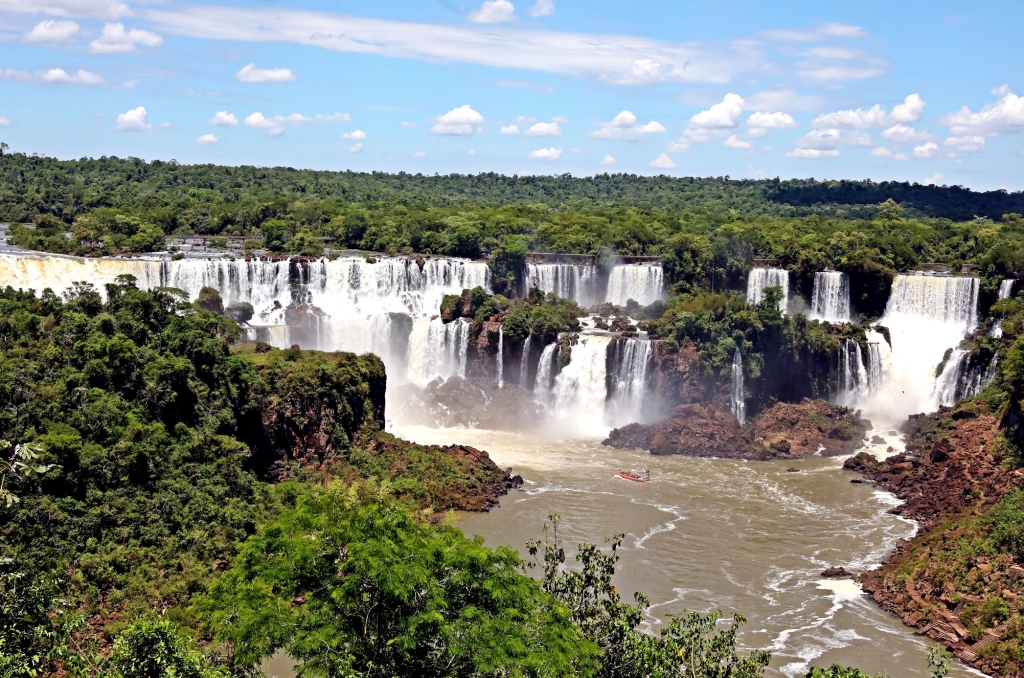
The walkway follows beside the falls for a remarkable 1 ½ km. We walked slowly, stopping often to take in the scenery that changed as we made our way along the falls. A dozen waterfalls turned into 100 and then a staggering 275. Water was cascading at random intervals. Some were large and ferocious; others were narrow streams of water. Each on their own would have been a gorgeous site but all of them together makes Iguaçu one of the most beautiful, if not the most beautiful waterfall in the world.
If I were a judge in a competition of most beautiful waterfall in the world, Iguaçu would get an A+++ for setting, design and execution.




At first we were almost too distracted by the many waterfalls falls to notice the large amount of colourful butterflies around us. Purple, red, blue and orange wings were fluttering around us as we walked down the path.



The highlight of the waterfall is a long narrow, horseshoe shaped gorge where water gushes from both sides. The Devil’s Throat (Garganta do Diabo) has so much power that you actually can’t see inside because of the amount of spray of blocking the view. After spending well over an hour walking the length of the Iguaçu we walked down a set of stairs and on to the long board walk that takes you close the mouth of the Devil’s Throat.

We were soon soaking wet from the mist, but it didn’t matter, the view is much better than the mist is annoying. From the platform you are surrounded by Iguaçu and you can really feel its power.


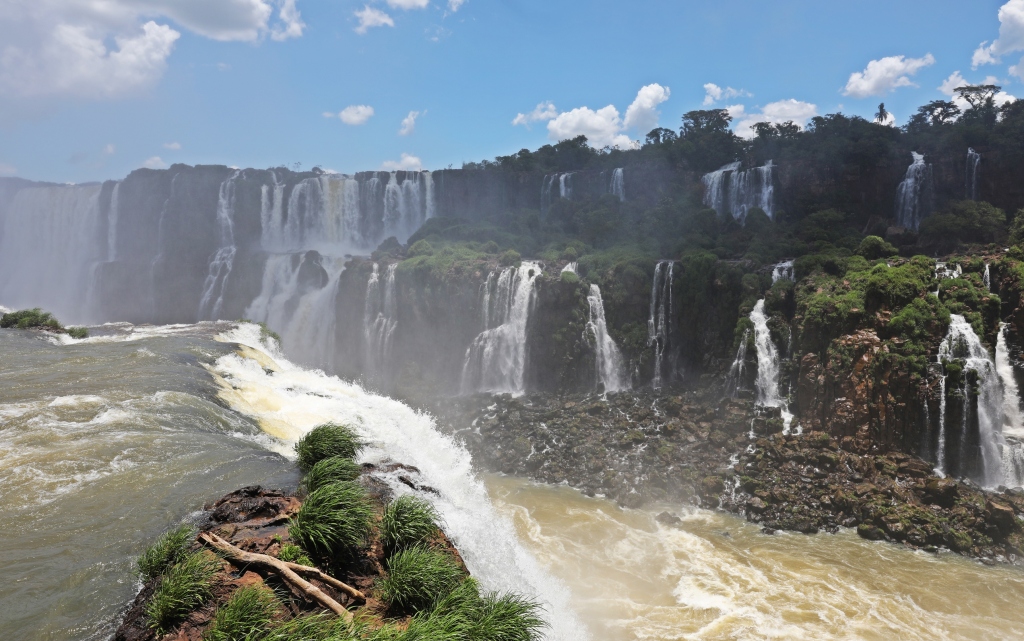

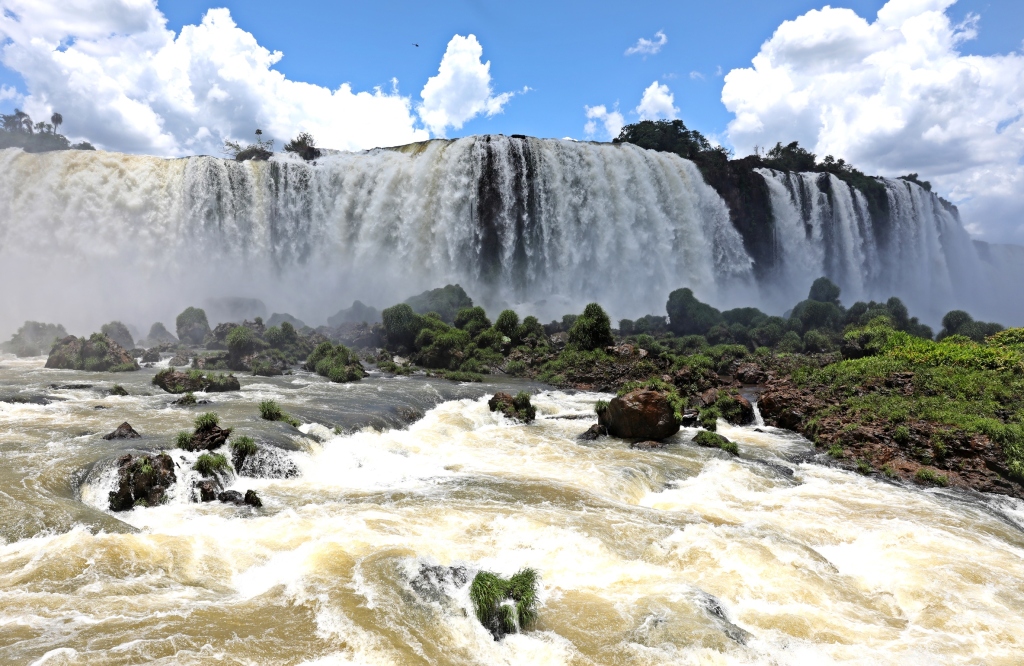
It was amazing to watch daredevil swallows as they darted in and out of the powerful falls . They have nests in the rocks behind the cascades.

A view point above the falls gives a better view of Devil’s Throat, but you still can’t see it fully. We knew we wanted a better look.

To fully realize the breadth of this waterfall you must see if from above. It was from a helicopter that we were finally able to get a full view of this amazing natural beauty. The 10 minute helicopter ride began by following the calm, flat river as it gently flows through the dense jungle. In the distance we could see high sprays of water letting us know where to find it.
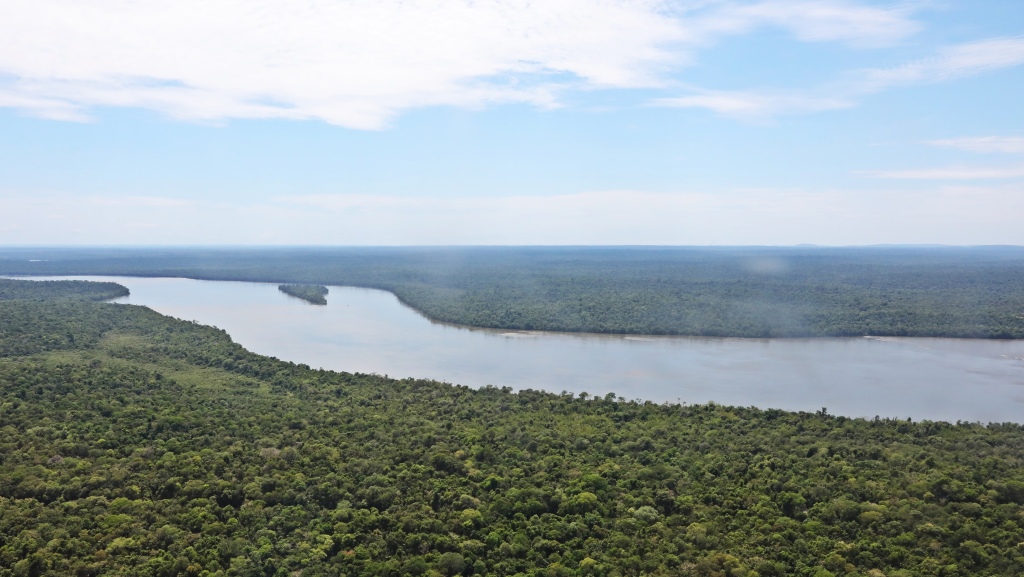

Suddenly, the gentle river meets the canyon and much of it drops straight down the 80 m tall cliffs. Other parts of the river though look as if the water is desperately trying to avoid the canyon, going further and further down stream, seeking another way. Eventually the river finally cedes to its outcome creating a waterfall that is 2.7 km long with 275 individual falls.
From the helicopter, the view was incredible. We could see how the light plays with the spray forming colourful rainbows.

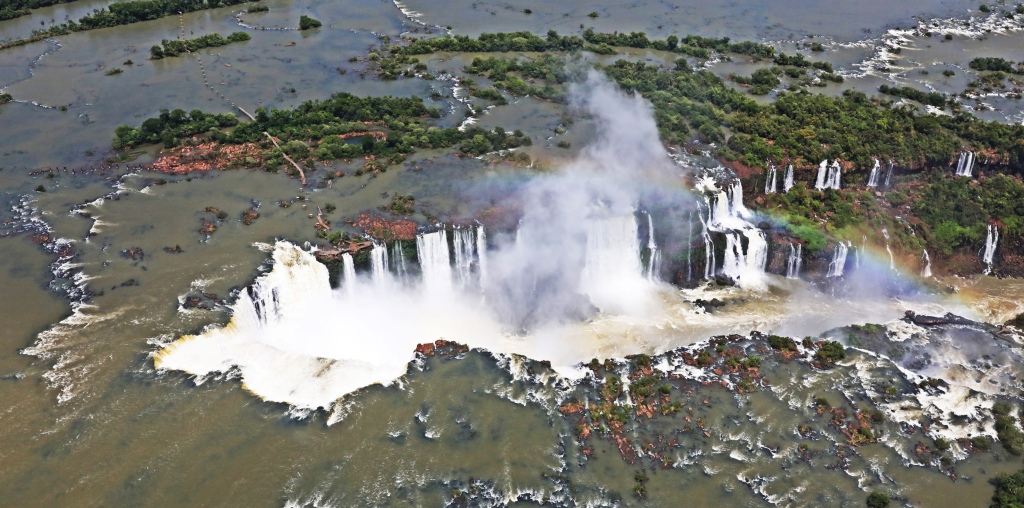

Foz do Iguaçu
The city Foz do Iguaçu (Mouth of Iguaçu) is a busy, but nice city 20 km from the waterfall. Even though it’s the closest access to the falls in Brazil, its downtown does not feel touristy. It has clean, tree-lined streets with lot of restaurants and shopping malls. There’s not a lot to do in town, but on its outskirts is the confluence of Iguaçu and Parana Rivers which forms the borders between Brazil, Argentina and Paraguay.

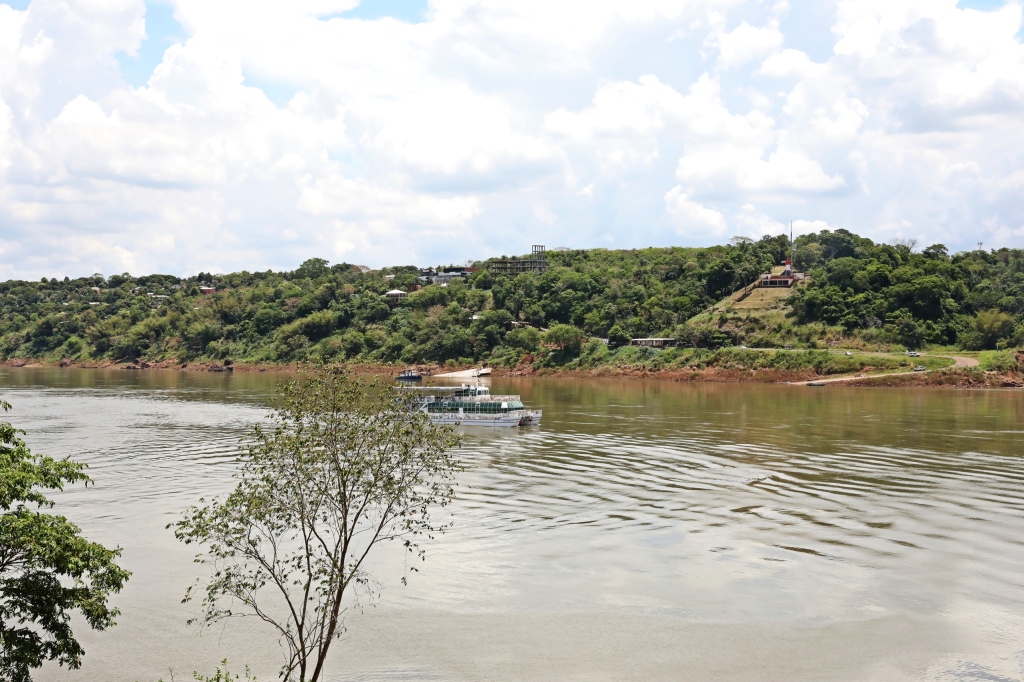
When we were waiting for the bus we noticed the courteous city workers cutting the grass. They had a portable wall between them and traffic. We think it was to protect cars from debris from their weed-eaters.

How to visit Iguaçu Falls
The Brazilian side of the falls can be seen from Parque Nacional do Iguaçu (Iguaçu National Park) 20 km from Foz do Iguaçu. The park is open daily from 9 am until 5 pm. To get to the falls you can hire one of the many tour agencies in town or on-line, but it’s very easy to go on your own. Taxis or Uber can drive you to the ticket counter. It’s also easy to take the public bus. Ask your hotel where the stop is for Bus 120 (R$5/$1USD). It leaves downtown every 20-30 minutes.
Your park ticket includes a bus that takes you to the walking trails. The first bus stop is for boat tours. We got off at the second stop which is across from Belmond Hotel das Cataratas so we could walk the entire length of the falls. If you don’t want to walk you can stay on the bus all the way to Devil’s Throat. Entry fee is R$83 ($16 USD) for foreigners.
Other ways to see the falls include a helicopter tour or boat rides. We highly recommend taking the helicopter tour.
You can also visit the Argentina side which is what we intended to do. It is supposed to have the best view of Devil’s Throat. Unfortunately two trails, including the one to Devil’s Throat have been damaged and are closed. (Note it is spelled Iguazú in Spanish).
How to get to Foz do Iguaçu
The city of Foz is very accessible by plane, car or bus. The international airport is 14 km outside of town and the bus depot (Rodoviária) is 6 km away. If you’re driving or taking a bus it is 13 hours to São Paulo and 6 hours to Curitiba.
When to visit
Rainy season is from December to March so this is when the falls will have the most water, but the skies are more likely to be cloudy. Blue skies are more common between April and October. We visited in December and had a mix of rainy days and blue skies.
Where to stay
Most people will stay in downtown Foz do Iguaçu. There are many restaurants and hotels in the area. If you want to splurge though, stay at Belmond Hotel das Cataratas in the National Park. It’s right across from the first viewpoint so would be able to visit the falls multiple times and more easily go during the best weather.

Coming Next – Top Places To Visit In Brazil
For pictures from other blogs go to Gallery at monkeystale.ca
To read about more of our adventures go to Destinations.
If you like what you read, please comment or share (with credit) using the links below
💙💙
LikeLiked by 2 people
What an absolutely incredible site! I love waterfalls so to see this in person would just be amazing. The butterflies are a nice touch too 🙂
LikeLiked by 2 people
It is incredible, almost too beautiful to believe. A waterfall lover like you should see this one! Maggie
LikeLike
I can almost hear the roar of the falling sheets of water. Such a magnificent marvel of nature. Also, thank you for including the butterflies. They’re so pretty.
LikeLiked by 2 people
It is a true marvel, no one could have thought to design this! Glad you like the butterflies, Maggie
LikeLiked by 1 person
I’m starting the ‘big three’ waterfalls – Niagara, Victoria, Iguaçu – when going to Canada 🇨🇦 in a few weeks.
LikeLiked by 2 people
Enjoy! Good to see Niagara first and not last. Is this your train trip across the country? Maggie
LikeLiked by 1 person
Indeed! Halifax – Montreal – Toronto – Vancouver. Niagara from Toronto.
And indeed I’ve read Niagara is the lesser impressive of the 3.
LikeLiked by 1 person
Have a great trip! No Calgary or Banff?
LikeLiked by 1 person
Not this time. Choices had to be made. But we do go to Whistler.
LikeLiked by 1 person
Magical. There are no other words to describe such a beautiful scene. Thanks for sharing Maggie. Allan
LikeLiked by 2 people
So true, thanks Allan, Maggie
LikeLike
What an incredible waterfall!
LikeLiked by 2 people
It is!! 😊
LikeLiked by 1 person
Wow, what an incredible landscape to experience. Your photos capture the scenery and natures wonders superbly. Thanks for sharing, a great post🤩 Rich
LikeLiked by 2 people
Thanks Rich! It is such an incredible natural wonder. 😊 Maggie
LikeLiked by 1 person
Wow! I don’t even know what else there is to say. I think the photos speak for themselves
LikeLiked by 2 people
😊
LikeLike
Those helicopter shots really give you a sense of the scale of the place! Fantastic!
LikeLiked by 2 people
Yes, it’s hard to imagine what 2.7km of waterfall looks like! So we had to do it 😊
LikeLiked by 1 person
Yes, having seen your photos, I think I would wish to have that panorama too!!
LikeLiked by 1 person
Your photo documentation of Iguaçu Falls is fabulous! Every pictorial angle shows its breathtaking beauty. Thank you!
LikeLiked by 1 person
Oh this brings back memories of our visit to Igazu (the Argentinian side) in 2010. We didn’t do the helicopter tour but I remember all of the butterflies and the magnificent falls. Nice pics (Suzanne)
LikeLiked by 2 people
Thanks Suzanne, isn’t it incredible!? Maggie
LikeLike
Stunningly beautiful! I visited Iguaçu Falls on the Brazilian and on the Argentinian side. The first visit offered better overviews, on the second you walk closer to the Falls. In Argentina it got very crowded at the end of January.
Thank you for reminding me of this marvelous place and your great description and photos.
LikeLiked by 2 people
Glad to bring back memories! I wish we had gone to Argentina but without Devil’s Throat being open it didn’t seem worth it. Thanks fornsharing your experience! Maggie
LikeLike
All your photos are beautiful, but those of the waterfalls are superb.
I can’t imagine the fantastic impression to see them live
LikeLiked by 2 people
It was almost unbelievable to see them in person. Thanks Luisa Maggie
LikeLike
Oh wow. I am also speechless. Thanks for sharing this. I love how the landscape is still natural. No wax museums etc. in site.
LikeLiked by 2 people
Well on the edge of town are a few kitchy places, but they are well outside the park and not in your face like Niagara.
LikeLiked by 1 person
I have read about this fall many times. The first picture doesn’t give an impression of its grand size but the aerial view shows something else. Also, the strenth of the water current is evident from the close up pictures.
LikeLiked by 2 people
Yes you can’t see it all from one spot, it’s quite an incredible site! 😊 Maggie
LikeLike
We got to see these wonderful falls several years ago – quite spectacular!
LikeLiked by 3 people
Aren’t they!?😊
LikeLiked by 1 person
Just to avoid confusions: the falls are on the Iguacu river. The Parana river is în aval of the falls. Paraguay is very close, but the falls are only in Argentina and Brasil. It’s a wonderful place.
LikeLiked by 2 people
Oh sorry, I mislabeled the picture. Thanks for letting me know. Maggie
LikeLiked by 1 person
“from Singapore to Sri Lanka” – from the North Pole to Antarctica😀
LikeLike
Fabulous descriptions conjuring up the power of Iguaçu Falls, and photos that demonstrate that power too 😀 I was as awed by them as you – I think the most impressive falls we’ve seen, even more so than Victoria and Niagara! We splurged on the Hotel das Cataratas so loved having the falls on our doorstep. But we didn’t do the helicopter flight although having done the one at Victoria Falls I wish that we had, As you say, it’s by far the best way to appreciate the scale and geology of these amazing falls!
LikeLiked by 2 people
I haven’t seen Victoria but I can’t imagine them being nicer than these. Aparantly Eleanor Rosevelt said ‘Oh poor Niagara’ when she saw Iguacu! The helicopter was worth every penny. 😊
LikeLiked by 1 person
To be honest I would say Victoria are pretty much on a par with these, and both well ahead of Niagara. I have a post about our helicopter ride there if you’d like to compare the two: https://www.toonsarah-travels.blog/lens-artists-challenge-120-what-a-treat/ There was an unusually large amount of spray when we visited so photos close to the falls were difficult, but I really should write up the walk we did there some time!
LikeLiked by 1 person
Thanks I’ll look at it.
LikeLiked by 1 person
The first time I heard of Iguacu Falls was in a clothing catalog, of all things, but since that time, I’ve been intrigued. Your photos are spectacular, and I loved getting to see the falls from the air! This destination is near the top of my list, and your post probably just moved it up a few notches. Thank you for sharing your insights on this beautiful place.
LikeLiked by 1 person
Phenomenal! What else can you say? Absolutely awesome photos, especially around the Devil’s Throat.
LikeLiked by 2 people
Thanks Jo, it is quite phenomenal! Maggie
LikeLiked by 1 person
This is a bucket list item for me to see these incredible falls! Stunning pictures! I can see why you would need to see the falls from above to really see them 🙂
LikeLiked by 2 people
Yes there is no one spot where you can see the full length of them except helicopter. They are so beautiful, keep them on your list!! Maggie
LikeLiked by 1 person
I visited from the Argentine side many moons ago. Such an amazing place! Those 88 butterflies amazed me! I remember just being amazed and in awe of everything around me!
LikeLiked by 2 people
It’s incredible isn’t it! And the 88s are so pretty, but so quick,, it was difficult to take pictures. Maggie
LikeLiked by 1 person
I appreciate you paying for the helicopter ride (which, frankly, would make me a little nervous) so that I could get a helicopter view without having to go up in a helicopter. Spectacular!!
LikeLiked by 2 people
Haha, I was so excited I didn’t even think of anything bad that could happen. 😊
LikeLiked by 1 person
That is simply outstanding! Mel
LikeLiked by 2 people
It is 😊😊
LikeLiked by 1 person
Iguaçu Falls is a wondeful place…💙 I’ve visited few years back… Beautiful photographs! 💙
LikeLiked by 2 people
Thank you Agata, it is incredible isn’t it?! Maggie
LikeLiked by 1 person
Paradise 💙
LikeLike
Lovely photos of this amazing natural wonder, Maggie and Richard! I love waterfalls, but I have never seen anything quite like this, even Niagara Falls! ❤
LikeLiked by 2 people
Apparently Eleanor Roosevelt said ‘oh poor Niagara’ when she saw Iguacu. 😊 It is beyond belief.
LikeLiked by 1 person
Wonderful, breathtaking place. No wonder you were so emotional when it all first came into view. This really must be one of the world’s most fabulous places.
LikeLiked by 2 people
I think it may be, at least in terms of waterfalls it is 😊 Maggie
LikeLiked by 1 person
This brought back some great memories. I first went to Iguacu (Brazil) in 1978, then to Iguazu (Argentina) in 2013. I honestly don’t know which is better, but for sure the helicopter is best! Fabulous photographs.
Alison
LikeLiked by 2 people
Oh wow twice! You’re very lucky. The view from the helicopter was incredible! Maggie
LikeLiked by 1 person
Spectacular, your photos are absolutely stunning and yet I bet no photo can do justice to these mighty and magnificent falls. Truly a place to see at least once in life. I was glad to read that your high expectations were not high enough. The views from the helicopter are absolutely worth whatever price you paid. I love the idea of staying a couple of nights at Belmond Hotel das Cataratas and having the falls right on one’s doorstep.
LikeLiked by 2 people
Thanks Leighton, it is the most amazing waterfall I’ve ever seen! Because it’s so massive the only way to really see it is by helicopter. It was definitely worth it. The hotel would be an ideal spot to stay, right on the edge of the falls.
LikeLiked by 1 person
Oh wow, they are absolutely amazing! It’s a shame a photo can’t tell us the sounds and feelings of being there because it looks so awesome. I’d definitely stay in that hotel as well – so special.
LikeLiked by 2 people
It is something to experience in person! The hotel is lovely and has an amazing location on the edge of the falls. You would love jt!!
LikeLike
Wow, the waterfalls are stunning Maggie and although you’ve captured them beautifully, I’m sure they are even more spectacular when you’re actually there.
LikeLiked by 2 people
Yes they’re are so many and it’s so long that there’s no way to capture it all in one picture. It’s an amazing waterfall 😊 Maggie
LikeLiked by 1 person
Stunningly gorgeous Maggie. I’d get nervous too!~ ❣️
LikeLiked by 2 people
Yes I was so worried I’d be disappointed, well I was the opposite 😊 By the way congrats on your book. I had to leave many comments on uour site because I know you have to approve them each time. 😊 Maggie
LikeLiked by 1 person
I be you were. Oh and thanks so much Maggie. Seriously I should haven’t to approve you.. I’ll go check.. Thanks so much! 💗
LikeLike
Beautiful waterfall. i come from Indonesia, i have never been come here. hope one day i can go to this place
LikeLiked by 2 people
Iguaçu Falls are unbelievably gorgeous I hope you get there one day 😊 Maggie
LikeLike
Wow! Those falls are spectacular, Maggie. Lovely butterflies, too.
LikeLiked by 2 people
Thanks Kerry, the waterfalls are beyond words. Beautiful falls and so many butterflies too! It was one I’ll keep in my memories!! Maggie
LikeLiked by 1 person
🦋🦋
LikeLike
We’ve been to the Argentina side, and it’s hard to imagine this side is even BETTER! (It is; I agree.) We loved our slow amble down all the boardwalks and trails, and like you, we found our expectations exceeded. Now that I see your butterfly pics, I think we saw a bunch also! (Monkeys, too – how about you?)
LikeLiked by 2 people
Monkeys!!! No we didn’t see any. We saw a coati and some lizards, but that’s it. When I tried to find the names of some of the butterflies on Google Images some of your pictures were near the top of the list!
LikeLiked by 1 person
I had to do that Google search because I could not imagine any of my photos or online activity meriting such visibility, and I saw that it was Leggy Peggy! 🙂 I can see how Leggy and Lexie might get mixed up, but alas, I toil in obscurity while Peggy has a gazillion followers! (Very cool to see a coati – not sure I have ever seen one in the wild.)
LikeLiked by 1 person
Oh shoot, sorry Lex! I guess it was Leggy Peggy. We have seen a few coatis in Central and South America, they’re always fun to see 😊
LikeLiked by 1 person
When I think of the most spectacular waterfalls in the world, three names always come up in my mind: Niagara Falls, Victoria Falls, and of course Iguaçu Falls. It’s so great to see this natural wonder through your photos, both taken on the ground and up from a helicopter. That shot of the spray visible from afar amid the lush jungle made me think of the excitement you must have felt when you saw it for the first time. Speaking of the view from above, in some of your photos I noticed footpaths that seems incomplete. But when you mentioned about the damaged trails on the Argentinian side, I wonder if those are the ones.
LikeLiked by 2 people
It is such an incredibly gorgeous waterfall, nature is really amazing. I really didn’t want to be disappointed by expecting too much, but I’m not sure you could ever have too high of expectations. Niagara doesn’t even come close, but I haven’t seen Victoria. You have good eyes. You can see some of the broken trails on the Argentina side near Devil’s Throat. A little further on, in the middle of the river is the boardwalk we went to. It would have been great to see it from Argentina, but not if we couldn’t go to Devil’s Throat. This was a highlight of Brazil. 😊
LikeLiked by 2 people
The views from the helicopter of Iguaçu falls are spectacular…such a grand place to visit. I can’t imagine the deep thunder of the falls and/or trekking nearby. Wow!
Love the happy sight of butterflies. How amazing! It is interesting that you noted the contrast between the power and excitement of the mouth of the falls in contrast to the town Foz do Iguaçu.
A beautiful sharing as always. This one is beyond awesome. Thank you.
LikeLiked by 2 people
It is beyond awesome!! It is funny that the town is quiet and non-touristy even though it’s on the edge of one of the most visited places in Brazil. Thanks Suzette. Maggie
LikeLiked by 1 person
It’s incredible how many waterfalls there are. Your pictures are gorgeous. And how awesome to see it all from up in the air too for a different perspective.
LikeLiked by 2 people
That is a spectacular place. I’m surprised I had never heard of it. Your stories and images never disappoint!
LikeLiked by 1 person
Thanks Rob, Iguaçu Falls is one of the top 3 waterfalls in the world. It is so much more beautiful than I had ever expected. 😊 Maggie
LikeLike
I had the chance to visit both sides in the same day, even leaving from Ciudad del Este in Paraguay. The two sides complement each other well but don’t make up for the frustration of seeing everything as if from a helicopter, well done!
LikeLiked by 2 people
Thanks! We had planned on going to Argentina but once we realized one of the trails were closed we decided not to go. One day I’d love to see it from Argentina, and a boat!!
LikeLiked by 1 person
Wow. That’s the sort of place you’d only expect to see in a movie – a sci-fi flick featuring another planet. Amazing some of the things you can see on this one.
LikeLiked by 2 people
This is definitely one of the planets best waterfalls. It’s crazy how nature can create these places 😊 Maggie
LikeLiked by 2 people
When I see waterfalls these days, I think of how I need to organize my email inbox because it’s like Niagra Falls. Now, I’m going to say Iguacu Falls lol
LikeLiked by 2 people
Haha only if your email is coming g from hundreds of places at once !! 😊
LikeLiked by 1 person
Oh my goodness! Those falls are insane. I just got back from Ontario and visiting Niagra Falls. Absolutely no comparison. I love the different levels, and how they go through the trees. Good on you for taking the heli tour. Makes a world of difference.
LikeLiked by 2 people
They are unbelievable! The helicopter ride was the trip of a lifetime. 😊 Maggie
LikeLiked by 1 person
Wonderful photos and posts! The flight reminded me of The Flight of Angles I took over Victoria Falls, Zimbabwe back in 1985 – just spectacular.
LikeLiked by 2 people
The helicopter was a highlight of our entire trip! I haven’t been to Victoria Falls but Iguaçu is spectacular! Thanks for your comments! Maggie
LikeLiked by 1 person
Not sure if I asked this before, but have you been to the incredible Angel Falls in Venezuela?
LikeLiked by 1 person
No we haven’t been to Venezuela. I bet Angel Falls is amazing!
LikeLiked by 1 person
It’s a harder one to get to but it blows your mind! I Sailed to Venezuela from the US, then Dominican Republic in 2008, but managed to do several inland trips. Always hard leaving your home in a dodgy port. 😉
LikeLiked by 1 person
Yes I imagine you wouldn’t be too comfortable wandering too far away from your joat in some parts of Venezuela. Maybe some day we’ll get there, we’d love to see Angel Falls and the Tepuis.
LikeLiked by 1 person
Hope you get there as it’s an incredible country.
LikeLike
I absolutely understand your (very) high rating for these incredibly beautiful waterfalls! Your photos are stunning …but I especially like the ones you took while standing on the boardwalk – it almost looks like you’re finding yourself in between the falls! But I agree, from high up in the sky, there’s just no better view!
LikeLiked by 2 people
On the boardwalk we were in the middle of it all, and we had the wet clothes to prove it! But seeing it from a helicopter was a highlight. (No pun intended)
LikeLiked by 1 person
What an incredible adventure!!! I was thrilled by all of your pictures. The waterfalls are simply magnificent – breathtaking, I imagine. And among all that were those completely lovely and colorful butterflies……..and those birds with their nests behind the cascading falls! How marvelous. Thank you for sharing.
LikeLiked by 2 people
Thanks Linda, they are the most spectacular waterfalls I’ve ever see, and likely will ever see. It was fun to watch those crazy sparrows fly in and out ofnthe powerful waterfall. 😊Maggie
LikeLiked by 1 person
I’ve seen photos of Iguaçu Falls before, but didn’t realize how many segments and levels it encompasses. What a treat to see it from above! And the lovely butterflies as well.
LikeLiked by 2 people
I thought it was nice at the first viewpoint, but then seeing the entire waterfall together, it’s almost unimaginable! Thanks for your comments Ruth! Maggie
LikeLiked by 1 person
I loved Iguacu! It has been years since I have been. The length and the power!! It puts all other waterfalls to shame
LikeLiked by 2 people
So true! It I amazing isn’t it!!
LikeLike
Simply incredible scenes. 😊👍
LikeLiked by 2 people
Thanks Pepper, it is an amazing waterfall 😊
LikeLiked by 1 person
Your pics are wonderful. Wish I was right there. 😊
LikeLiked by 1 person